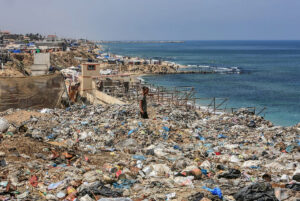Toxic waste, water-borne diseases, vast carbon emissions: Dr. Mariam Abd El Hay describes the myriad harms of Israel’s assault to the region’s ecosystems.

Displaced Palestinians near the sea in Deir al-Balah, June 20, 2024. (Abed Rahim Khatib/Flash90)
Nathalie Rozanes reports in +972 September 5, 2024
“Ever-worsening shortages of water and electricity. Catastrophic flooding in dense urban areas. Food insecurity exacerbated by drastic temperature increases, reduction in overall rainfall, and the long-term impact of toxic chemicals.”
This is what climate researchers Khalil Abu Yahia, Natasha Westheimer, and Mor Gilboa, writing in +972 Magazine more than two years ago, predicted was in store for Gaza’s near-term future. Israel’s ceaseless bombardment of the Strip over the past 11 months has caused unspeakable humanitarian consequences, but it will also have dramatic and lasting effects on Gaza’s already imperiled natural environment — and indeed, that of the entire region.
“It is near impossible to think about the climate crisis amongst this much death and destruction,” Westheimer wrote this past November, after Abu Yahia was killed in an Israeli airstrike. “But the reality is, this last month has set Gaza even deeper into a humanitarian crisis, and its two million residents are more vulnerable to the impacts of climate change than ever.”
In June, the Center for Applied Environmental Diplomacy at the Arava Institute for Environmental Studies published an extensive new report on the environmental impact of Israel’s ongoing assault on Gaza. The report covers myriad environmental harms of the war — from the vast amount of toxic dust released by bombing buildings, to the breakdown of waste management, and the destruction of water treatment facilities and proliferation of water-borne illnesses.
While it is Palestinians in Gaza who face the most severe threat, the report makes clear that the entire territory between the Jordan River and the Mediterranean Sea is part of one ecosystem, in which health and environment are interconnected in a vulnerable equilibrium. This was made particularly evident by the recent discovery of poliovirus in Gaza’s wastewater. The Israeli army set about delivering Polio booster shots to Israeli soldiers, before eventually agreeing to a vaccination campaign for Palestinian children in the territory under the age of 10; Israel has also taken a sudden interest in reconstructing the wastewater management infrastructure that it destroyed.

Health workers vaccinate Palestinian children against polio virus in Deir al-Balah, September 1, 2024. (Abed Rahim Khatib/Flash90)
The report also highlights the link between armed conflict and global warming. On July 21, the planet experienced the hottest day on record; in the Middle East, temperatures are rising on average twice as fast as the rest of the world.
To better understand the environmental impact of the war, +972 spoke with Dr. Mariam Abd El Hay, a researcher in social dynamics and the environmental impacts of conflicts and a Palestinian citizen of Israel from the city of Tira. Abd El Hay is the author of the new report, to which Elaine Donderer and Dr. David Lehrer, the center’s director, also contributed. The interview has been edited for length and clarity.
More …


